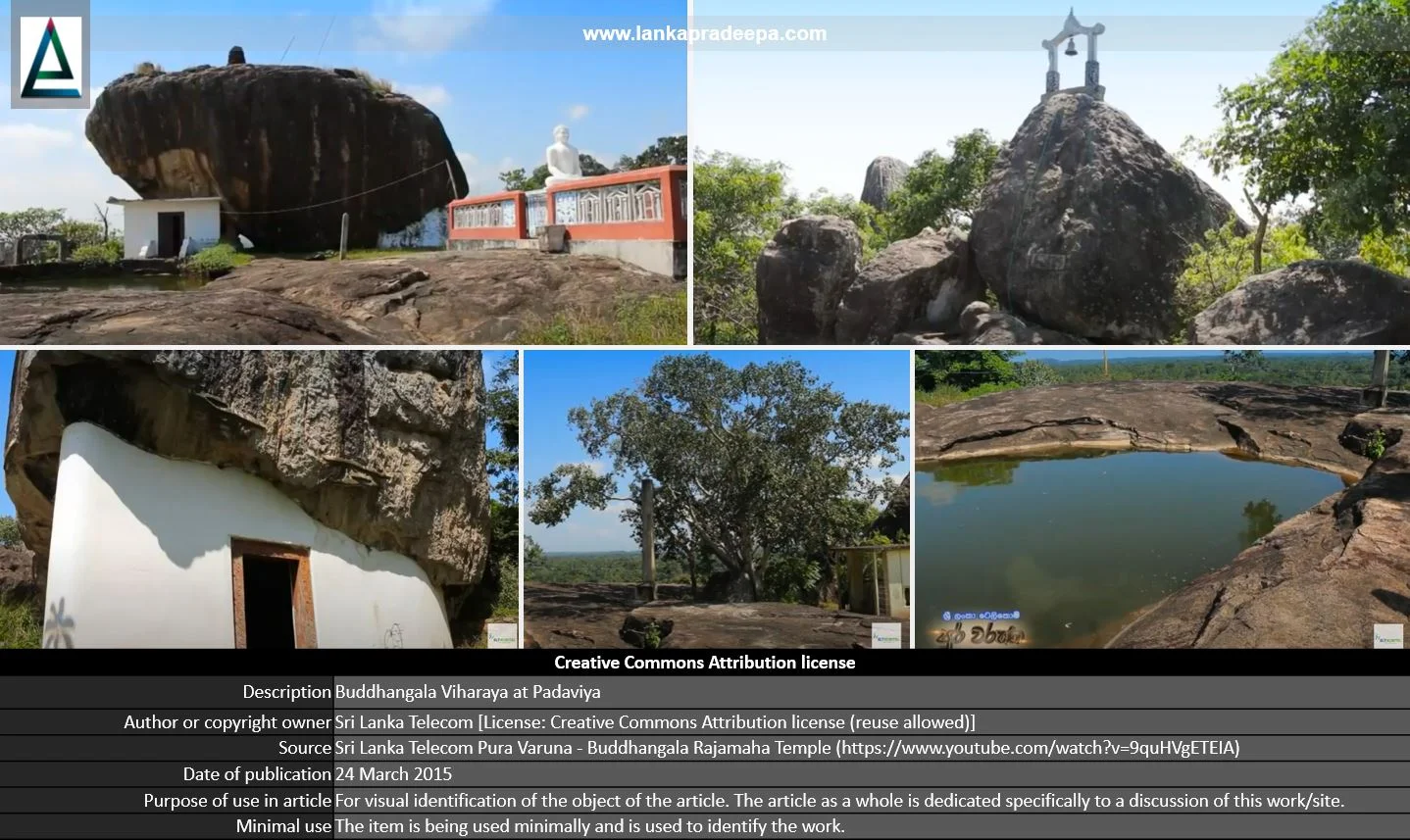
Buddhangala Raja Maha Viharaya, formerly Buddhanehela Raja Maha Vehera (Sinhala: පදවිය බුද්ධංගල විහාරය, බුද්ධන්නේහෙල රජමහා වෙහෙර), is a Buddhist temple situated in Buddhangala village near Padaviya in Anuradhapura District, Sri Lanka.
History
This Buddhist monastery site is believed to have been established in the pre-Christian era and existed until the 10th century A.D. (Medhananda, 2003). Two rock inscriptions and two pillar inscriptions have been found at the site (Medhananda, 2003). Of them, the 10th-century inscription discovered in one of the caves reveals the name of the site as Nagirigala situated in the Dana-dakadara division (Nicholas, 1963).
Buddhanehela Pillar Inscription
This inscription inscribed on all four sides of a stone pillar 6 ft. 4 in. in height and 9 in. in square was first recorded in 1891 (Brohier, 1963; Ranawella, 2004; Wickremasinghe, 1912). At the time of discovery, it is said to have been placed upside down to serve as a door-jamb of a Saiva shrine of about the 11th or early 12th century A.D. (Ranawella, 2004; Wickremasinghe, 1912). Therefore, this pillar is assumed to be brought to the present site from a nearby place (Ranawella, 2004; Wickremasinghe, 1912).Dated to the reign of King Sena III (938-946 A.D.), the object of this record was to register the grant of certain immunities in respect of six Kiriyas of land, consisting of six estates, in a village named Nannarugama (probably Naga-nagara in Pali) situated in a region named Dana-dakdara, which had been assigned to a Buddhist monk named Harideya, an incumbent of a monastery named Nahiriya (Nicholas, 1963; Ranawella, 2004). Dana-dakdara, according to S. Paranavitana, is the district around the main channel issuing from Dhanavapi, the modern Padaviya Wewa (Nicholas, 1963).
The monastery site
Located on an outcrop of rock, the site consists of five caves and a dilapidated Stupa (Brohier, 1963; Wickremasinghe, 1912). It is reported that one cave had been used as a Pillaiyar Kovil while another cave contained a statue of sedent Buddha protected by a seven-hooded Naga (Brohier, 1963). Presently, the ancient Stupa at the top of the rock has been completely destroyed (Medhananda, 2003).
Also, the ruins of ancient buildings and other religious artefacts such as a base stone of a standing Buddha statue, two Siri Pathul Gal (stone-carved footprints of the Buddha), an Asana, a stone container with five cavities and broken pieces of Buddha statues have been discovered scattered on the temple premises (Medhananda, 2003; Ślączka, 2007).
References
1) Brohier, R., 1963. Antiquarian Notes on Padaviya. The Journal of the Ceylon Branch of the Royal Asiatic Society of Great Britain & Ireland, 8(2), pp.245-264.
2) Medhananda, E., 2003. Pacheena passa - Uttara passa: Negenahira palata ha uturu palate Sinhala bauddha urumaya (In Sinhala). Dayawansa Jayakody & Company. Colombo. ISBN: 978-955-686-112-9. pp.381-384.
3) Nicholas, C. W., 1963. Historical topography of ancient and medieval Ceylon. Journal of the Ceylon Branch of the Royal Asiatic Society, New Series, vol VI, Special Number: Colombo. Royal Asiatic Society (Ceylon Branch). p.87.
4) Ranawella G.S., 2004. Inscription of Ceylon. Volume V, Part II. Department of Archaeology. pp.146-151.
5) Ślączka, A.A., 2007. Temple consecration rituals in Ancient India: text and archaeology (Vol. 26). Brill. p.380.
6) Wickremasinghe, D.M.D.Z., 1912. Epigraphia Zeylanica: Being lithic and other inscription of Ceylon (Vol. I). London. Archaeological Survey of Ceylon. pp.191-200.
Explore Other Nearby Attractions
Location Map (Google)
This page was last updated on 11 June 2023

